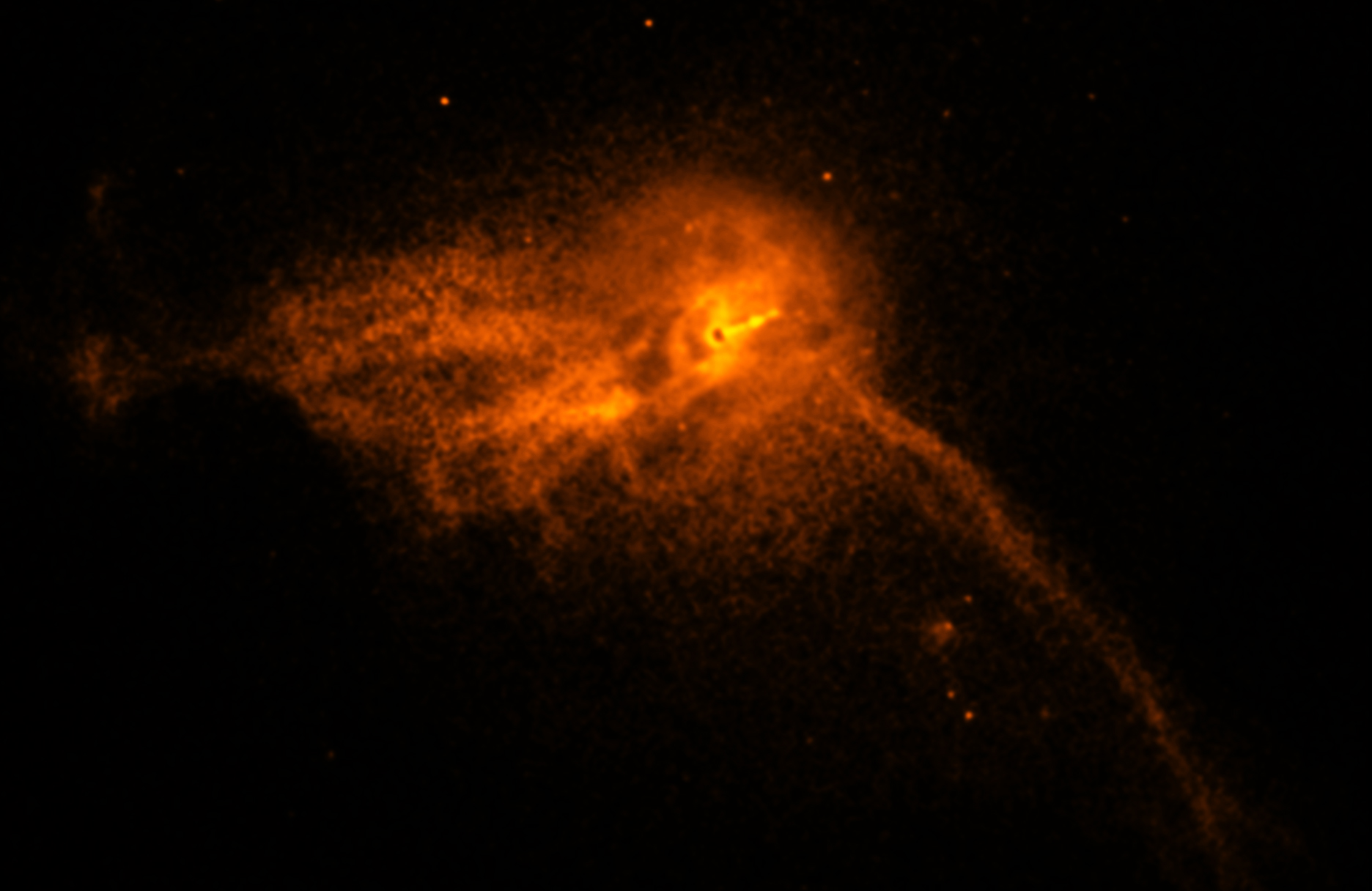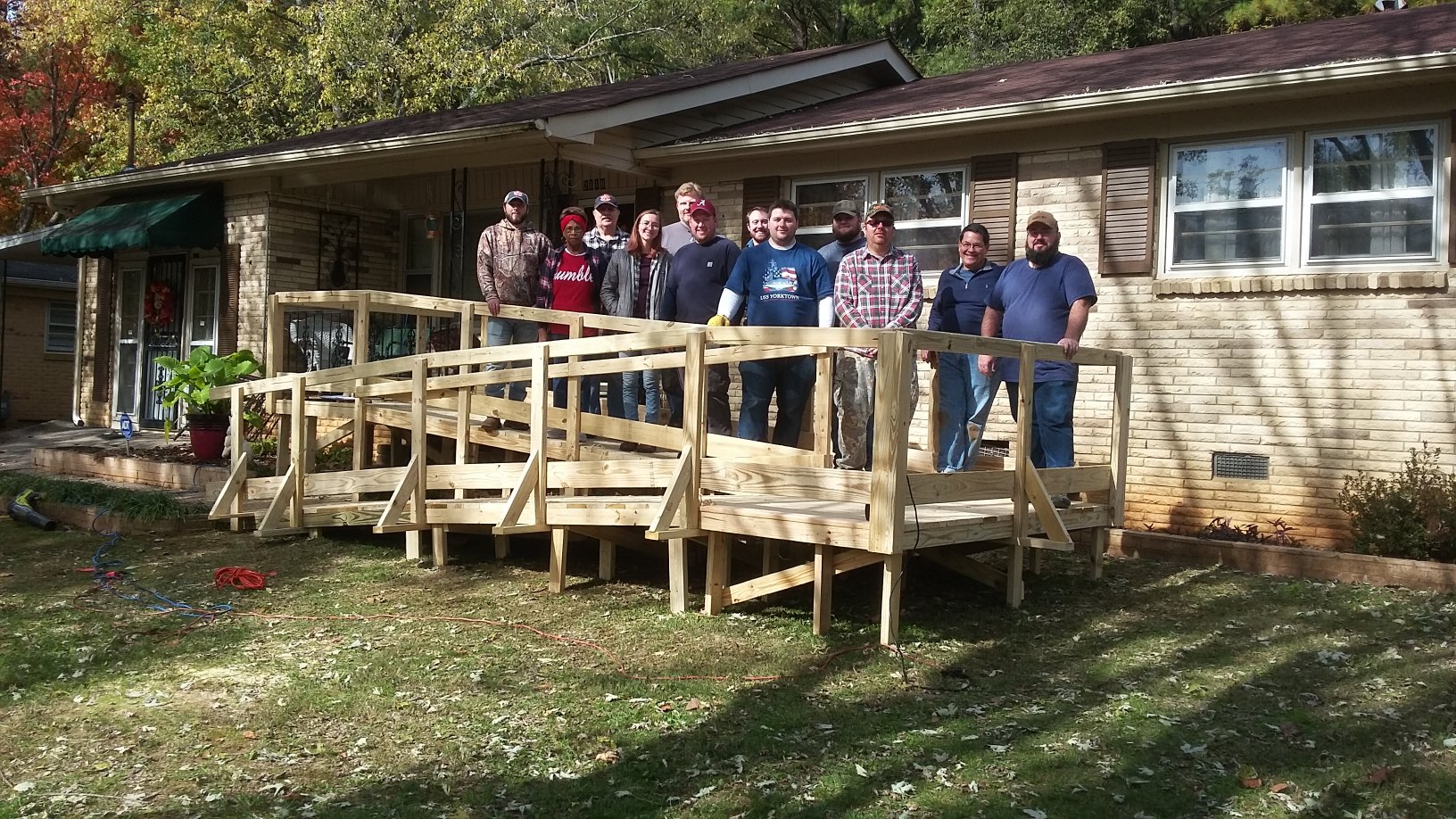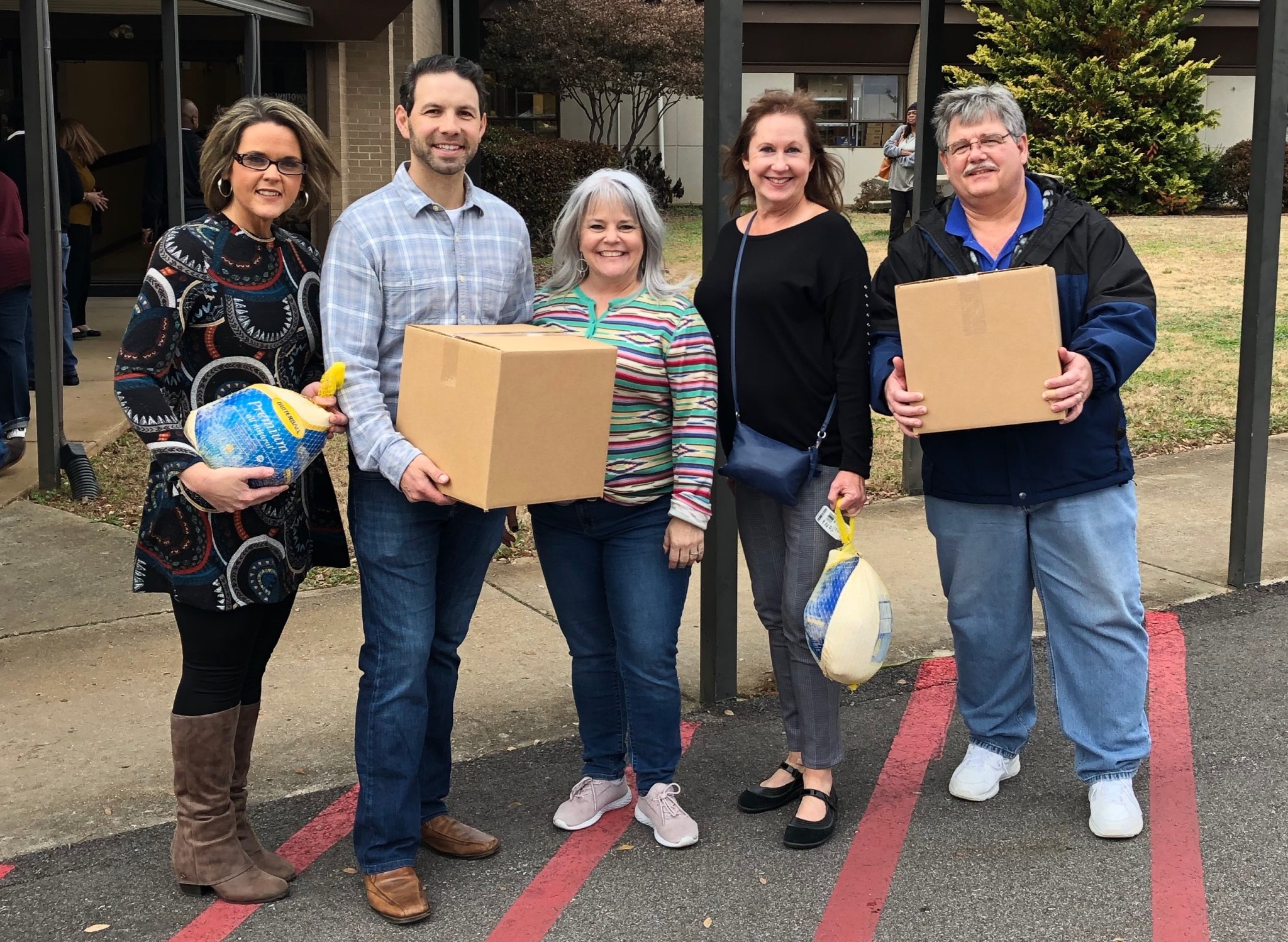In This Week’s Star
- First NASA Artemis Rocket Core Stage Loaded on Pegasus Barge
- NASA’s Newest Astronauts Ready for Space Station, Moon, Mars Missions
- FIRST Robotics Kickoff Event Returns to Rocket City
- Famous Black Hole Has Jet Pushing Cosmic Speed Limit
- Annual Federal Charity Campaign Concludes with Surge of Marshall Support
- This Week in NASA History: STS-61C Launches – Jan. 12, 1986
First NASA Artemis Rocket Core Stage Loaded on Pegasus Barge
The first Space Launch System rocket core stage for NASA’s Artemis program completed manufacturing work at NASA’s Michoud Assembly Facility and was loaded onto the agency’s Pegasus barge Jan. 8 for delivery to NASA’s Stennis Space Center. With NASA Deputy Administrator James Morhard in attendance, NASA rolled out the core stage for the SLS rocket onto Pegasus in preparation for the Green Run test series, the final test campaign ahead of the agency’s first Artemis launch.
“NASA’s Space Launch System core stage is part the Artemis program, which is a national asset,” Morhard said. “The SLS rocket was built to deliver American astronauts and maximum payloads to the Moon and deep space destinations. Rolling out the completed core stage from NASA’s Michoud Assembly Facility to go on to Stennis for further testing is an exciting leap forward in the Artemis program as NASA teams make progress toward the launch pad.”
The roughly 1.3-mile trip from the Michoud factory to the barge’s dock is just the start of the SLS flight hardware’s journey. Pegasus will ferry the SLS core stage from Michoud to Stennis, where the core stage will be lifted and placed into the historic B-2 Test Stand for the core stage Green Run test campaign that will begin later this year. The Green Run series is a comprehensive test campaign of the stage — from its avionics and propulsion systems to its four RS-25 engines — that will verify the core stage design ready for launch.
“Completion of this first-time build of the Space Launch System rocket’s core stages puts humans on the cusp of a new era of space exploration,” said John Honeycutt, the SLS program manager at NASA’s Marshall Space Flight Center. “NASA’s SLS rocket is designed to evolve so a variety of missions can be accomplished, first to the Moon for the Artemis missions and then to Mars and other deep space destinations.”
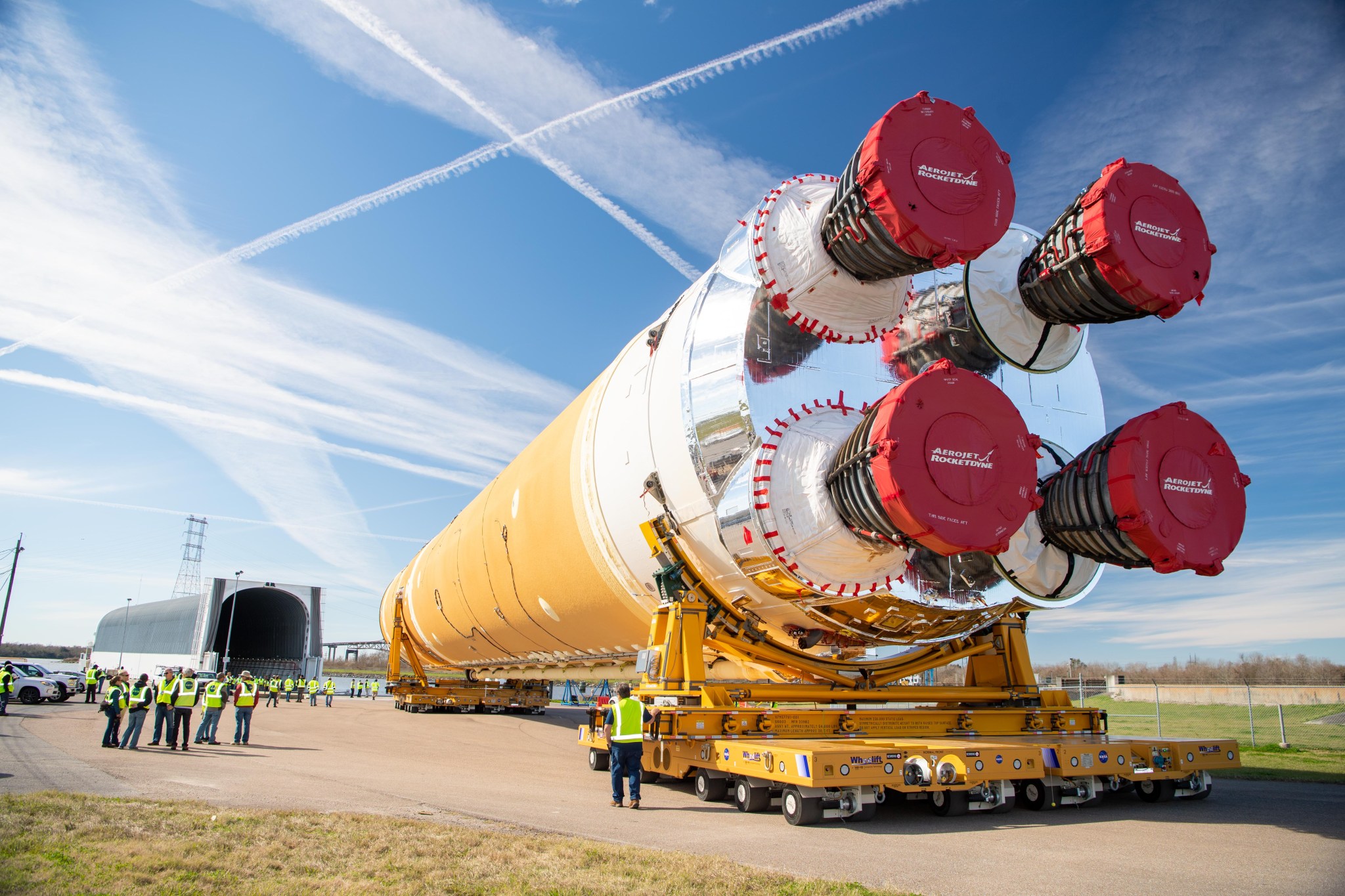
Before launching NASA’s Orion spacecraft to the Moon, the SLS rocket stage will take the same water route that the first stages of the Saturn V rocket did when it was transported from Michoud to Stennis for testing during the Apollo program in the 1960s and 1970s. Pegasus, which previously ferried the space shuttle tanks from Michoud to NASA’s Kennedy Space Center, was modified to make it longer and stronger to accommodate the core stage and ferry the SLS rocket hardware. Following Green Run, the barge will carry the core stage flight hardware to Kennedy for launch preparations.
The SLS rocket’s core stage is the largest stage NASA has ever built at Michoud, including the Saturn V rocket stages for the agency’s first Moon missions. With a design featuring some of the most sophisticated hardware ever built for spaceflight, the core stage is the powerhouse of the SLS rocket. In addition to its miles of complex cabling, avionics and propulsion systems, its two propellant tanks hold a combined 733,000 gallons of propellant to power the four RS-25 engines.
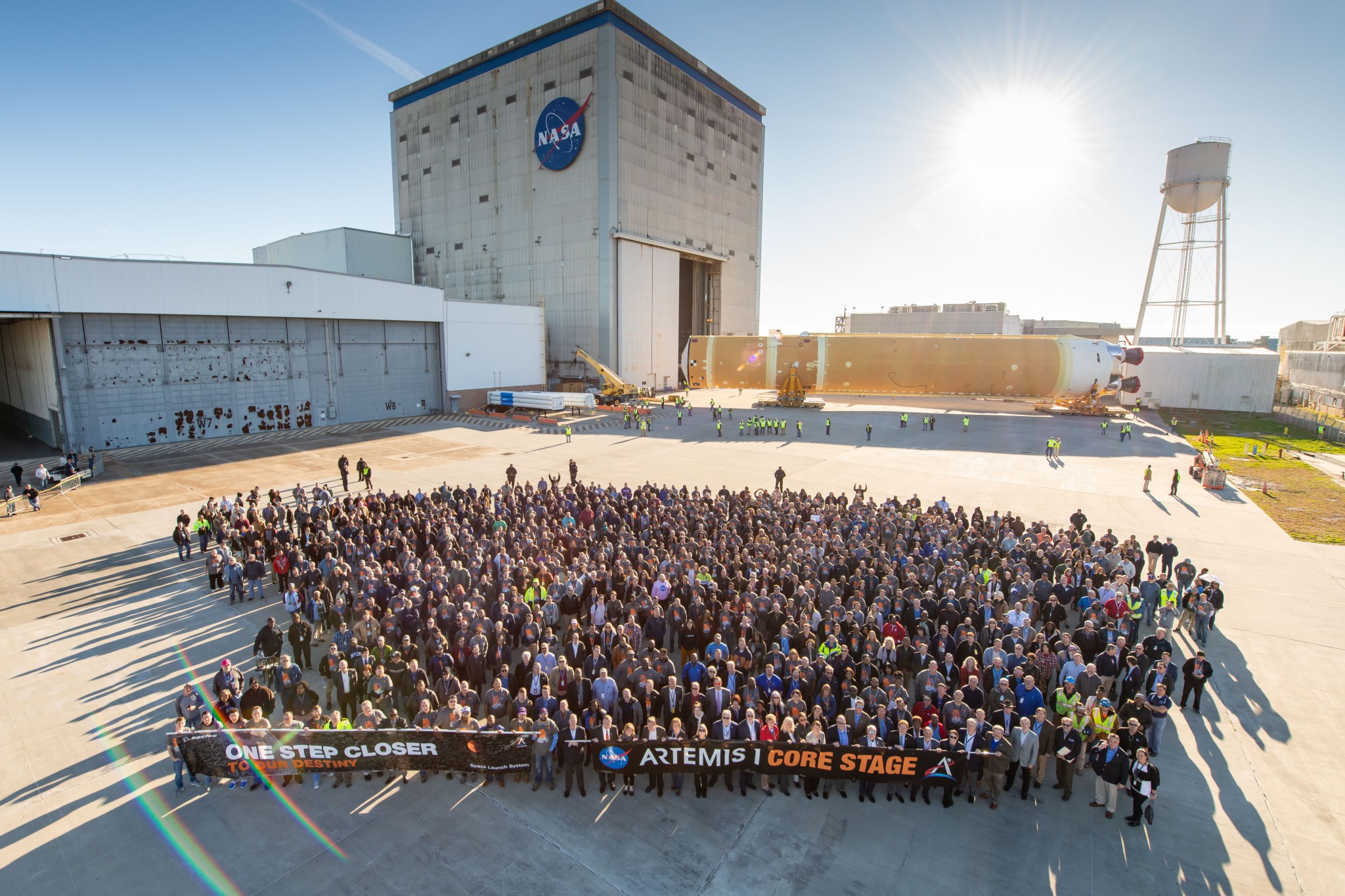
“This is a historic moment for NASA’s Artemis program and a proud time for the Space Launch System Core Stage team as the first flight article leaves the factory floor,” said Julie Bassler, NASA SLS Stages manager. “Rollout of the core stage to Stennis ahead of the core stage Green Run test series signals an exciting next phase as NASA prepares for the first Artemis launch. The Green Run test series will verify the stage is ready to ship to the launch site.’”
Teams at Michoud are working in tandem to manufacture and assemble core stages for the first three Artemis lunar missions. With the assembly of the core stage for Artemis I complete, NASA is focusing its efforts on building the core stages for Artemis II, the first crewed mission of SLS and Orion, and Artemis III, the mission that will send American astronauts to the lunar south pole.
NASA’s Newest Astronauts Ready for Space Station, Moon, Mars Missions
In NASA’s first public graduation ceremony for astronauts, the agency welcomed 13 new members — 11 Americans and two Canadians — to the astronaut corps Jan. 10, swelling the ranks of those eligible for spaceflight assignments to expand humanity’s horizons in space for generations to come.
The new astronauts, the first to graduate since the agency announced its Artemis program, successfully completed more than two years of required basic training. They may be assigned to missions destined for the International Space Station, the Moon and Mars. With a goal of sustainable lunar exploration later this decade, NASA will send the first woman and next man to the surface of the Moon by 2024. Annual lunar missions are planned thereafter and human exploration of Mars is targeted for the mid-2030s.
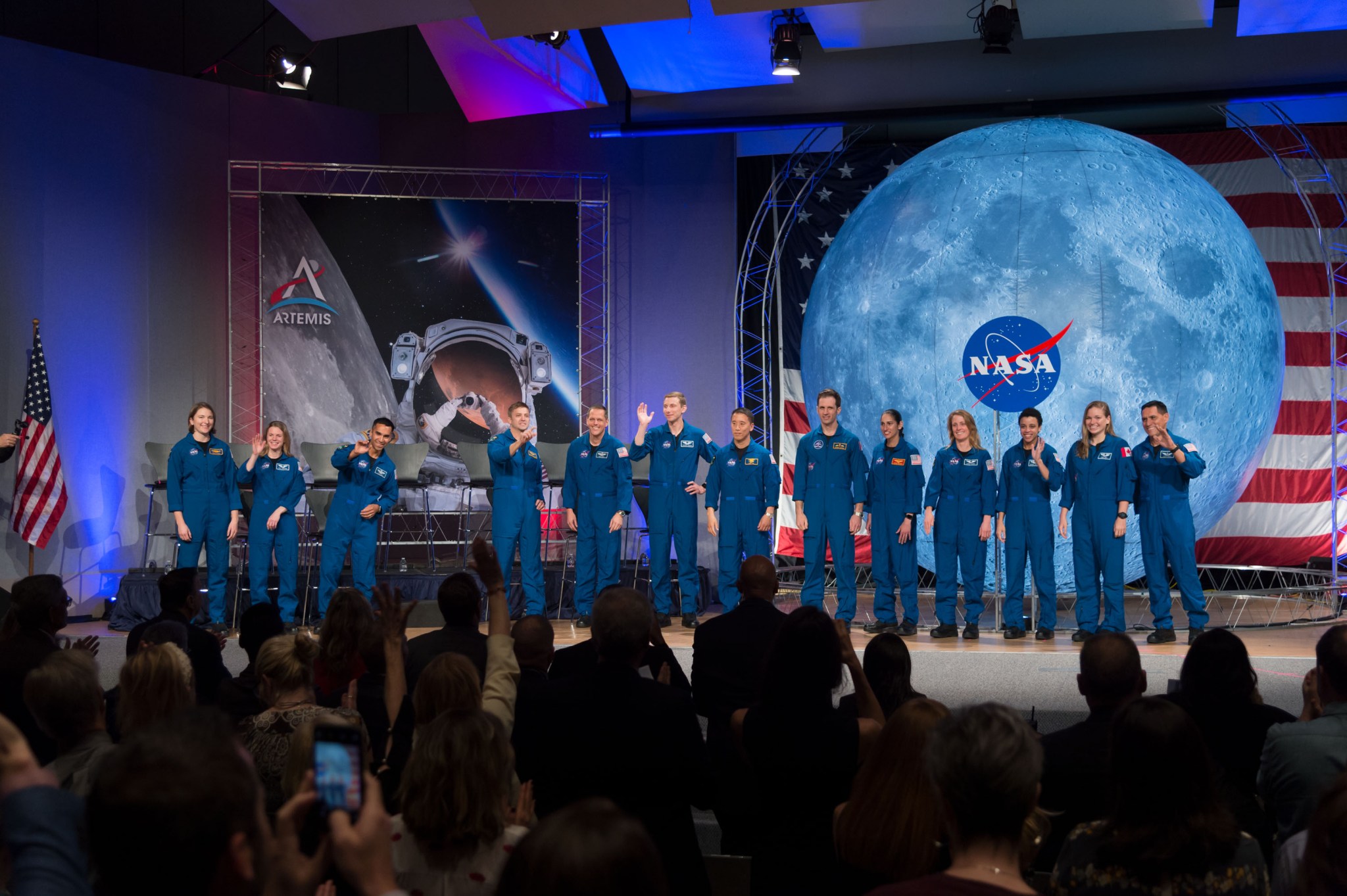
To learn more about the new astronauts, read the full story here, and find additional images here.
“These individuals represent the best of America, and what an incredible time for them to join our astronaut corps,” NASA Administrator Jim Bridenstine said during the graduation ceremony at NASA’s Johnson Space Center. “2020 will mark the return of launching American astronauts on American rockets from American soil, and will be an important year of progress for our Artemis program and missions to the Moon and beyond.”
Selected for training in 2017, the NASA astronaut candidates were chosen from a record-setting pool of more than 18,000 applicants. Bobby Watkins, director of the Human Exploration Development & Operations Office at NASA’s Marshall Space Flight Center, was a member of the selection committee. He recalls the process as “arduous, exacting” — and ultimately a privilege to be part of.
“We had such a talented pool of candidates, and the depth of knowledge, expertise and commitment among this diverse group of graduates is inspiring and humbling to see,” Watkins said. “Not only because they include future commanders, pilots and specialists who will fly on the Space Launch System and Orion and pilot our Human Landing System to the lunar surface, but because our astronauts often go on to become administrators and directors across NASA. They are the vanguard of our mission in space, and many continue to guide that mission in the years following their service to the astronaut corps.”
At the graduation ceremony, each new astronaut received a silver pin, a tradition dating back to the selection of NASA’s Mercury 7 astronauts in 1959. Each will receive a gold pin upon completion of their first spaceflights.
“I congratulate these exceptional men and women on being the first graduating class of the Artemis program,” said Sen. Ted Cruz of Texas, who was among the speakers at the event. “They are the pioneers of the final frontier whose work will help fortify America’s leadership in space for generations to come.”
Including the current class, NASA now has 48 active astronauts. NASA is also considering plans to open the application process this spring for the next class of astronaut candidates.
Astronaut candidate training for the new graduates included instruction, practice and testing in spacewalking, robotics, International Space Station systems, T-38 jet proficiency and Russian language. As astronauts, they will help develop spacecraft, support current and future teams working in Earth orbit and ultimately join the roughly 500 people who have journeyed to space.
NASA continues its work aboard the space station, which, in November, will celebrate 20 consecutive years of human occupation. The agency also is on the verge of launching astronauts again aboard American commercial spacecraft, and is preparing to send humans to the Moon as part of the Artemis program.
FIRST Robotics Kickoff Event Returns to Rocket City

More than 200 members of the Artemis Generation gather at the U.S. Space & Rocket Center on Jan. 4 to kick off the 2020 FIRST Robotics competition season. Seventeen high school teams attended the educational event — a collaborative effort between NASA’s Marshall Space Flight Center, the U.S. Space & Rocket Center and the National Space Club of Huntsville — to witness this year’s game reveal and pick up their kit of parts. Teams now have six weeks to build, program and test a functional robot in preparation for district and regional competitions, including the Rocket City Regional to be held April 4 at the Von Braun Center. Inventor Dean Kamen founded “For Inspiration and Recognition of Science and Technology” in 1989 in Manchester, New Hampshire, to inspire young people to pursue careers in the fields of science, technology, engineering and math. NASA and its Robotics Alliance Project provide grants for high school teams and support for FIRST Robotics competitions around the country to address the critical national shortage in STEM career fields. NASA’s Science Mission Directorate coordinates and supports FIRST activities for the agency. For more information about FIRST programs and competitions, visit here. (NASA/Taylor Goodwin)
Famous Black Hole Has Jet Pushing Cosmic Speed Limit
Using NASA’s Chandra X-ray Observatory, astronomers have seen that the famous giant black hole in galaxy Messier 87 is propelling particles at speeds greater than 99% of the speed of light.
The Event Horizon Telescope Collaboration released the first image of a black hole with observations of the massive, dark object at the center of Messier 87, or M87, last April. This black hole – known as M87* — has a mass of about 6.5 billion times that of the Sun and is located about 55 million light-years from Earth.
For years, astronomers have observed radiation from a jet of high energy particles — powered by the black hole — blasting out of the center of M87. They have studied the jet in radio, optical and X-ray light, including with Chandra. And now by using Chandra observations, researchers have seen that sections of the jet are moving at nearly the speed of light.
“This is the first time such extreme speeds by a black hole’s jet have been recorded using X-ray data,” said Ralph Kraft of the Harvard-Smithsonian Center for Astrophysics in Cambridge, Massachusetts, who presented the study at the American Astronomical Society meeting in Honolulu, Hawaii. “We needed the sharp X-ray vision of Chandra to make these measurements.”
When matter gets close enough to a black hole, it enters into a swirling pattern called an accretion disk. Some material from the inner part of the accretion disk falls onto the black hole and some of it is redirected away from the black hole in the form of narrow beams, or jets, of material along magnetic field lines. Because this infall process is irregular, the jets are made of clumps or knots that can sometimes be identified with Chandra and other telescopes.
The researchers used Chandra observations from 2012 and 2017 to track the motion of two X-ray knots located within the jet about 900 and 2,500 light-years away from the black hole. The X-ray data show motion with apparent speeds of 6.3 times the speed of light for the X-ray knot closer to the black hole and 2.4 times the speed of light for the other.
This latest result shows the ability of X-rays to act as an accurate cosmic speed gun. The team observed that the feature moving with an apparent speed of 6.3 times the speed of light also faded by over 70% between 2012 and 2017. This fading was likely caused by particles’ loss of energy due to the radiation produced as they spiral around a magnetic field. For this to occur the team must be seeing X-rays from the same particles at both times, and not a moving wave.
“Our work gives the strongest evidence yet that particles in M87*’s jet are actually traveling at close to the cosmic speed limit,” Snios said.
NASA’s Marshall Space Flight Center manages the Chandra program. The Smithsonian Astrophysical Observatory’s Chandra X-ray Center controls science and flight operations from Cambridge and Burlington, Massachusetts.
Read the full story here.
Annual Federal Charity Campaign Concludes with Surge of Marshall Support
The Tennessee Valley Combined Federal Campaign giving season ended strong last week, with NASA’s Marshall Space Flight Center team donating a total of $309,974 and working 156 volunteer hours, numbers that will continue to rise as paper pledges are counted in the coming weeks.
Notably, monetary contributions exceeded last year’s total of $300,167, but organizers were inspired by the swell of volunteer hours, which more than doubled. The three-month effort is the annual federal government’s goodwill drive to benefit local, state and national charitable organizations.
“I am once again heartened at how the Marshall family has stepped up to show support for this year’s campaign, in particular by giving of their time,” said Mary Hovater, technical manager in the Office of Strategic Analysis & Communications who serves as Marshall CFC chair for 2019. “The charities and services in our area rely on these critical donations of time and funds to serve our communities. Our center’s generous donations, combined with those of our partners, will help them to continue to support the Tennessee Valley.”
The campaign kicked off in mid-October 2019 with a fair and rally that featured more than 40 area charity vendors. This year’s “Show Some Love” tagline was used to highlight weekly themes, such as disaster relief and mental health, and link donors to the hundreds of area charitable organizations and causes.
In addition to one-time or payroll-deducted monetary donations, employees could volunteer for a variety of in-person community service opportunities, from serving meals at the Downtown Rescue Mission to maintaining public nature trails for the Land Trust of North Alabama.
Marshall’s partners in the Tennessee Valley CFC include the U.S. Army Aviation and Missile Command and other federal agencies at Redstone Arsenal and in surrounding Alabama and Tennessee counties. Since CFC was founded in 1961, the national effort has raised more than $8.3 billion for charitable organizations.
This Week in NASA History: STS-61C Launches – Jan. 12, 1986
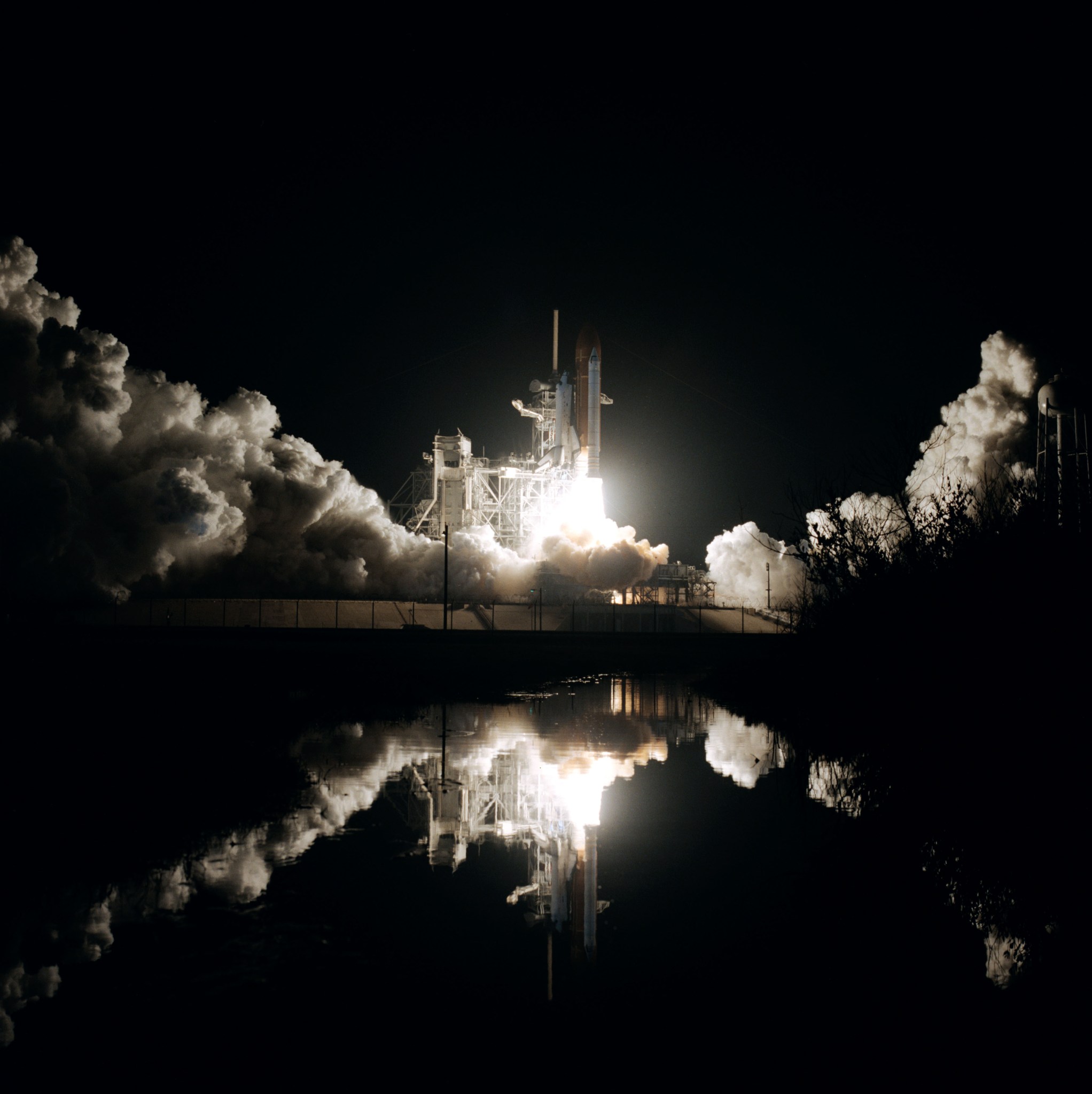
This week in 1986, space shuttle Columbia, mission STS-61C, launched from NASA’s Kennedy Space Center. The STS-61C mission successfully deployed the SATCOM KU-I satellite, which was attached to the Payload Assist Module-D2. Other payloads included Materials Science Laboratory-2, the infrared Imaging Experiment and Hand-held Protein Crystal Growth experiment. Today, the Payload Operations Integration Center at NASA’s Marshall Space Flight Center serves as “science central” for the International Space Station, working 24/7, 365 days a year in support of the orbiting laboratory’s science experiments. The NASA History Program is responsible for generating, disseminating and preserving NASA’s remarkable history and providing a comprehensive understanding of the institutional, cultural, social, political, economic, technological and scientific aspects of NASA’s activities in aeronautics and space. For more pictures like this one and to connect to NASA’s history, visit the Marshall History Program’s webpage. (NASA)


























